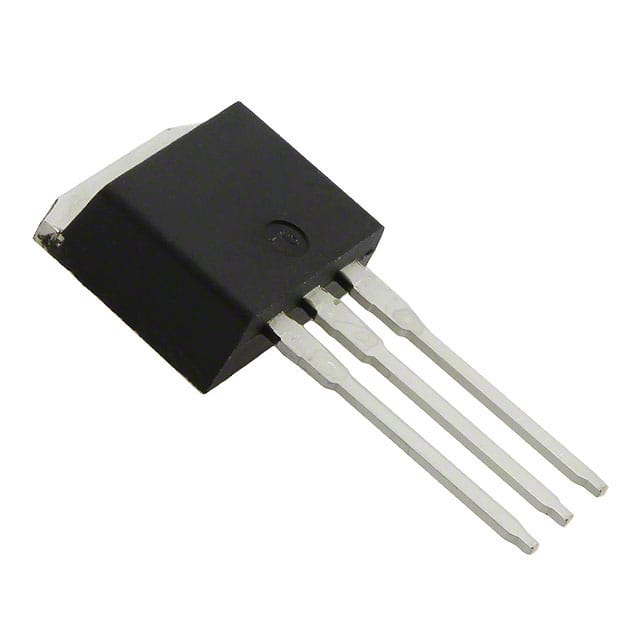IRFBC40AL
Product Overview
Category
The IRFBC40AL belongs to the category of power MOSFETs.
Use
It is commonly used in electronic circuits for switching and amplification applications.
Characteristics
- High voltage capability
- Low on-resistance
- Fast switching speed
Package
The IRFBC40AL is typically available in a TO-220AB package.
Essence
This power MOSFET is essential for controlling high-power loads in various electronic devices and systems.
Packaging/Quantity
It is usually packaged in reels or tubes, with quantities varying based on manufacturer specifications.
Specifications
- Drain-Source Voltage (VDS): 600V
- Continuous Drain Current (ID): 4.2A
- On-Resistance (RDS(on)): 1.5Ω
- Gate-Source Voltage (VGS): ±20V
- Total Power Dissipation (PD): 75W
Detailed Pin Configuration
The IRFBC40AL features a standard three-pin configuration: 1. Gate (G) 2. Drain (D) 3. Source (S)
Functional Features
- High voltage capability allows for use in various power applications.
- Low on-resistance minimizes power loss and heat generation.
- Fast switching speed enables efficient control of electronic loads.
Advantages
- Suitable for high-voltage applications
- Low on-resistance for reduced power dissipation
- Fast switching speed for improved efficiency
Disadvantages
- Limited continuous drain current compared to some alternative models
- Higher gate-source voltage requirement than certain alternatives
Working Principles
The IRFBC40AL operates based on the principles of field-effect transistors, utilizing the control of electric fields within the semiconductor material to regulate the flow of current between the drain and source terminals.
Detailed Application Field Plans
Power Supplies
The IRFBC40AL can be used in power supply circuits to efficiently switch high voltages and currents.
Motor Control
In motor control applications, this power MOSFET can effectively manage the power delivery to motors, enabling precise speed and direction control.
Lighting Systems
For lighting systems, the IRFBC40AL can be utilized to regulate the power supplied to different types of lights, offering efficient control and dimming capabilities.
Detailed and Complete Alternative Models
- IRFBC40 - Similar specifications with slightly different characteristics
- IRFBC40A - Variant with enhanced performance in certain parameters
- IRFBC40LC - Low-capacitance version suitable for specific applications
In conclusion, the IRFBC40AL power MOSFET offers high voltage capability, low on-resistance, and fast switching speed, making it suitable for a wide range of electronic applications. While it has advantages such as suitability for high-voltage applications and low on-resistance, it also has limitations in terms of continuous drain current and gate-source voltage requirements. Understanding its working principles and detailed application field plans can help maximize its potential in various electronic systems.
[Word Count: 443]
Senaraikan 10 soalan dan jawapan biasa yang berkaitan dengan aplikasi IRFBC40AL dalam penyelesaian teknikal
What is the IRFBC40AL?
- The IRFBC40AL is a power MOSFET transistor designed for high-speed switching applications in electronic circuits.
What are the key specifications of the IRFBC40AL?
- The IRFBC40AL has a maximum drain-source voltage of 600V, a continuous drain current of 4.2A, and a low on-resistance for efficient power handling.
In what types of technical solutions can the IRFBC40AL be used?
- The IRFBC40AL is commonly used in applications such as motor control, power supplies, inverters, and other high-frequency switching circuits.
What are the advantages of using the IRFBC40AL in technical solutions?
- The IRFBC40AL offers low on-resistance, fast switching speeds, and high efficiency, making it suitable for demanding power electronics applications.
How does the IRFBC40AL compare to similar MOSFET transistors?
- Compared to similar MOSFETs, the IRFBC40AL offers a good balance of performance, cost-effectiveness, and reliability, making it a popular choice for various technical solutions.
What are the typical operating conditions for the IRFBC40AL?
- The IRFBC40AL is typically operated within a temperature range of -55°C to 175°C and requires appropriate heat sinking for optimal performance.
Are there any specific considerations for driving the IRFBC40AL in a circuit?
- It's important to ensure that the gate drive voltage and current are within the specified limits to achieve reliable and efficient operation of the IRFBC40AL.
Can the IRFBC40AL be used in automotive applications?
- Yes, the IRFBC40AL can be used in automotive systems such as motor control, lighting, and power management due to its robust design and performance characteristics.
What protection features does the IRFBC40AL offer?
- The IRFBC40AL provides built-in protection against overcurrent, overvoltage, and thermal issues, enhancing the safety and reliability of the overall system.
Where can I find detailed application notes and reference designs for using the IRFBC40AL?
- Detailed application notes and reference designs for the IRFBC40AL can be found in the manufacturer's datasheets, application guides, and technical support resources.


